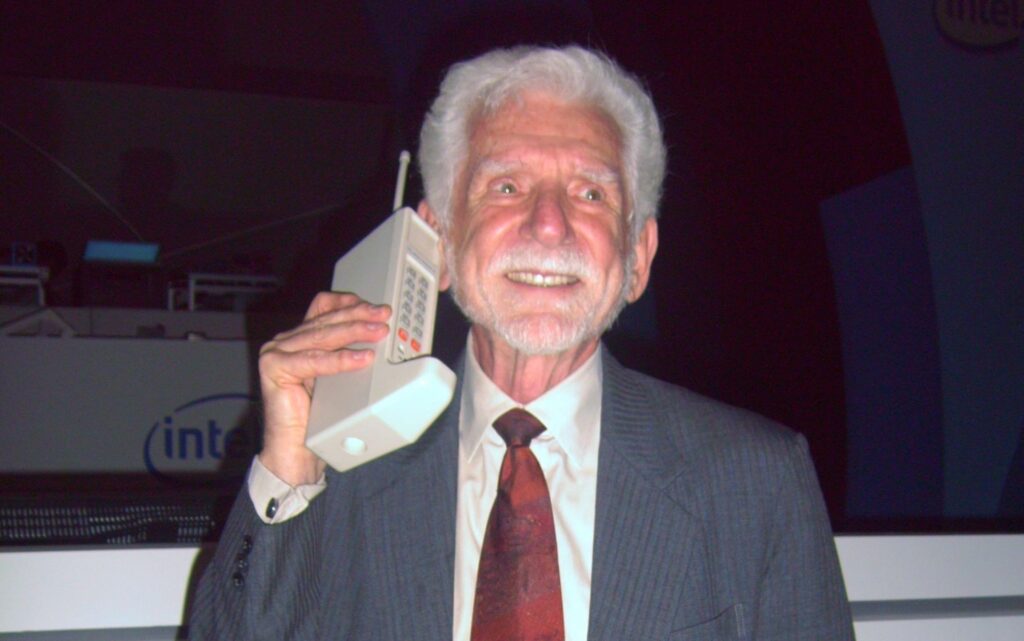Sure! Here’s the translation:
Fifty Years Later: The Call That Forever Changed How We Live and Connect
On April 3, 1973, New York City was the site of a moment that, while overlooked by many at the time, would mark the beginning of an unprecedented technological revolution: Martin Cooper, an engineer at Motorola, made the first call in history from a handheld mobile phone. With that simple gesture—dialing a number from the sidewalk and talking to a rival—Cooper ignited the spark of an era where communication would become truly personal, global, and wireless.
The Story Before the Call: The Dream of Personal Mobility
Martin Cooper was born in Chicago in 1928. After earning his degree in electrical engineering from the Illinois Institute of Technology and serving in the Navy, Cooper joined Motorola in 1954. Back then, mobile telephony was little more than a science fiction dream. Car phones, large and wired, were hardly a luxury reserved for an elite few. Bell Labs, their great rival, was betting on car phones; however, Cooper had a different vision: “Communication needed to be personal, and it needed to be with us at all times,” he would recall years later.
Throughout the 1960s and early 70s, Cooper led teams that developed portable radios for police, doctors, and emergency services. But his obsession was to ensure that anyone, anytime and anywhere, could make a wireless call.
The Technical Challenge: Birth of the DynaTAC
In a record time of just 90 days, Cooper and his team created the Motorola DynaTAC 8000X. The prototype weighed 2.5 pounds, measured 10 inches, and offered barely 20 minutes of battery life. However, it was truly portable and could be used on the street, not just in vehicles.
The historic first call was also a masterstroke of public relations: Cooper called engineer Joel Engel, leader of Bell Labs’ mobile phone project, from Fifth Avenue. “Joel, I’m calling you from a real mobile, a personal handheld phone,” was the message that ushered in the age of mobile telephony.
From Skepticism to Global Boom
Cooper’s bet didn’t convince everyone. In the 70s and 80s, many experts doubted there would be a market for handheld phones. The networks, infrastructure, and the cost of the first devices—around $4,000—limited access to executives and companies. The DynaTAC 8000X didn’t launch commercially until 1983, nearly a decade after that first call, but soon technological advances and cost reductions skyrocketed its adoption.
The evolution of mobile telephony has been meteoric. From those “bricks” with LED screens and giant batteries to today’s ultra-thin, multifunction smartphones, five decades of continuous advancement have led to component miniaturization, increased battery life, global network expansion, the emergence of digital technologies, mobile internet, instant messaging, video calls, and in recent years, integrated artificial intelligence in devices.
Today, over 8 billion mobile phones are active worldwide, and connectivity is a presumed right in most societies. But the starting point remains Cooper’s prototype and the belief that each person should have “their own number” and the ability to call from anywhere.
The Vision of a Pioneer: Technology to Improve Life
Throughout his career, Martin Cooper has been the author of over a hundred patents related to radio and wireless communication. In addition to his role as an inventor, Cooper advocates for universal access to technology and the need to develop innovations that improve people’s lives.
In an interview commemorating the 50th anniversary of his famous call (2023), Cooper reflected on the true meaning of his invention:
“The most important thing I’ve learned in these 50 years is that everything we do should be focused on enhancing the human experience. The mobile phone has changed how we work, learn, and connect. My greatest satisfaction is seeing that a dream, though improbable, can change the world.”
His philosophy continues to inspire new generations of engineers and entrepreneurs: “We need dreamers, people willing to try, fail, and try again.”
From the “Brick” to the Digital Era: Evolution of Mobile Calls
The first generation of mobile phones, based on analog technology (1G), only allowed voice calls. The devices were large, expensive, and had limited coverage. The arrival of the second generation (2G) in the 90s introduced digital calls and the first SMS, paving the way for messaging and better sound quality.
With the third generation (3G) and the expansion of mobile internet, video calling and the first connected applications emerged. The revolution solidified with the arrival of the smartphone, especially after the launch of the iPhone in 2007 and the development of Android, which integrated services, cameras, and multimedia capabilities.
Today, in the 4G and 5G era, mobile calls coexist with video conferencing applications, instant communication, and AI-based services, making communication more ubiquitous, rich, and secure than ever.
A Universal Legacy
At 95 years old, Martin Cooper is considered one of the great inventors of the 20th century, and his legacy remains more relevant than ever. If you’ve ever wondered who is responsible for you carrying a “supercomputer” in your pocket today, the answer lies in the vision and perseverance of an engineer who, half a century ago, dreamed of a more connected and free world.
The story of Martin Cooper is not just the birth of the mobile phone, but the human capacity to imagine, create, and transform society through technology. A legacy that continues to evolve… call by call.
Let me know if you need anything else!

